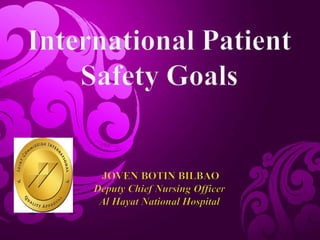
INTERNATIONAL PATIENT SAFETY GOALS
- 2. To promote specific improvements in patient safety. Represent proactive strategies to reduce the risk of medical error Provide clear priorities and solutions for improving patient safety. OBJECTIVE:
- 3. INTERNATIONALPATIENTSAFETY GOALS ( JCISTANDARDS 5TH EDITION AS 2014) 1.Identify Patients Correctly 2.Improve Effective Communication 3.Improve the Safety of High-alert Medications 4.Ensure Correct-Site, Correct-Procedure, Correct-Patient Surgery 5.Reduce the Risk of Health Care–Associated Infections 6.Reduce the Risk of Patient Harm Resulting from Falls
- 4. Goal 1: Identify Patients Correctly Ask for two identifiers including the FULL NAME , and MEDICAL RECORD NUMBER Verify patient identification before all invasive and diagnostic procedures. Patient identification wristbands for inpatients. “Time-out” before starting all surgical and invasive procedures (preventing wrong site, wrong procedure, wrong patient surgery) Not use these for identification Patients room numbers, locations
- 5. Goal 2: Improve Effective Communication Standards 2. Verbal/Telephone Order •The hospital develops and implements a process to improve the effectiveness of verbal and/ telephone communication among caregivers. Standard IPSG.2.1 •The hospital develops and implements a process for reporting critical results of diagnostic tests. Standard IPSG.2.1 •The hospital develops and implements a process for handover communication.
- 6. Ineffective Communication •Reporting critical test results –Potassium result was reported by lab to nurse –Nurse hears result as a very low value of 2.7. –After the patient's laboratory results are entered on the screen, it was seen as 8.7.
- 7. Effective communication, which is timely, accurate, complete, unambiguous, and understood by the recipient, reduces errors, and results in improved patient safety. Reporting the critical test results, Verbal and telephone orders that includes: writing down & reading back A standard communication method including asking and answering questions during hand-offs SBAR Inappropriate abbreviations, symbols and wordings Improve Effective Communication
- 8. Handovers of Patient Care within a Hospital Occur between health care providers, such as between physicians and other physicians or health care providers, or from one provider to another provider during shift changes; between different levels of care in the same hospital such as when the patient is moved from an intensive care unit to a medical unit or from an emergency department to the operating theatre; and From inpatient units to diagnostic or other treatment departments, such as radiology or physical therapy.
- 9. Goal 3: Improve the Safety of High-alert Medications IPSG.3 The hospital develops and implements a process to improve the safety of high-alert medications. IPSG.3.1 The hospital develops and implements a process to manage the safe use of concentrated electrolytes.
- 10. Improve the Safety of High-alert Medications When medications are part of the patient treatment plan, appropriate management is critical to ensuring patient safety. A frequently cited medication safety issue is the unintentional administration of concentrated electrolytes Potassium chloride [2mEq/ml or more concentrated], Potassium phosphate, sodium chloride [0.9% or more concentrated], Magnesium sulfate [50% or more concentrated]. Inadequate orientation of staff members. Remove the concentrated electrolytes from the patient care unit to the pharmacy. Areas where concentrated electrolytes are clinically necessary, Emergency Department Operating Theatre, Critical care Area •How they are clearly labeled and how they are stored
- 11. Goal 4: Ensure Correct-Site, Correct-Procedure, Correct-Patient Surgery •Ineffective or inadequate communication between members of the surgical team. •Lack of patient involvement in site marking, and lack of procedures for verifying the operative site. •Inadequate patient assessment and medical record review, a culture that does not support open communication among surgical team members, problems related to illegible handwriting and the use of abbreviations are frequent contributing factors. •The essential processes found in the Universal Protocol are Marking the surgical site; A preoperative verification process; and A time-out that is held immediately before the start of a procedure.
- 13. Marking the Surgical Site •Laterality, •Multiple structures (fingers, toes, lesions), or •Multiple Levels (spine) •The mark should be; –consistent throughout the organization –should be made by the person performing the procedure –should take place with the patient awake and aware if possible, –and must be visible after the patient is prepped and draped
- 14. Goal 5: Reduce the Risk of Health Care–Associated Infections Infection prevention and control. Catheter-associated urinary tract infections, blood stream infections and pneumonia (often associated with mechanical ventilation). Central to the elimination of these and other infections is proper hand hygiene. Hand hygiene guidelines CDC – Bundles *CDC: Centers for Disease Control and Prevention
- 15. Goal 6: Reduce the Risk of Patient Harm Resulting from Falls Falls account for a significant portion of injuries in hospitalized patients. Evaluate patients’ risk for falls Take action to reduce the risk of falling and to reduce the risk of injury should a fall occur. The evaluation could include fall history, medications and alcohol consumption review, gait and balance screening, and walking aids used by the patient. A fall-risk reduction program
- 16. Preventing Patient Falls Trainings to patients and patient families Not leaving bed without any help Nurse call and frequently used objects are placed near to the patient Bed height is fixed at the lowest level All side rails in the up position Instruct the patient to wear non-skid footwear Unused equipment is removed from the room Proper lighting
- 17. Thank You For Listening!
- 18. QUALITY IMPROVEMENT AND PATIENT SAFETY NURSING DEPARTMENT AL HAYAH NATIONAL HOSPITAL KHAMIST MUSHAIT
